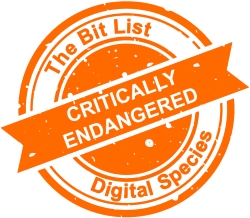Records of Non-Governmental Agencies
|
|
 |
|
|
Records of independent agencies and contractors that act on behalf of the state in the delivery of public services, and which may be present in many diverse forms, but for which the NGO or contractors may lack the capacity to meet the complex digital preservation requirements that arise, or may have a business motive to minimize or ignore requirements for the maintenance of the record. |
||
|
Digital Species: Public Records |
Trend in 2023:
|
Consensus Decision |
|
Added to List: 2019 |
Trend in 2024:
|
Previously: Critically Endangered |
|
Imminence of Action Action is recommended within twelve months, detailed assessment is a priority. |
Significance of Loss The loss of tools, data or services within this group would impact on many people and sectors. |
Effort to Preserve | Inevitability It would require a major effort to prevent or reduce losses in this group, possibly requiring the development of new preservation tools or techniques. |
|
Examples Born digital records of small and medium-sized agencies; fasting-changing internal manuals, advice or policies shared on intranets or EDRMS; records of care services; historic guidelines and manuals which evidence 'best practice at the time'; Documentation supporting long-lived contractual relations like Public Finance Initiatives; Organizational Slack channels; network drives; EDRMS; Email |
||
|
‘Practically Extinct’ in the Presence of Aggravating Conditions Lack of preservation infrastructure; conflation of backup with preservation; loss of authenticity or integrity; Long-lived business processes; poor storage; churn of staff; significant volumes or diversity of data; poorly developed digitization specifications; ill-informed records management; poorly developed migration or normalizations specifications; longstanding protocols or procedures that apply unsuitable paper processes to digital materials; encryption; political instability; lack of sustained funding; denial of responsibility; failure to include archives within contract from commissioning agency; Uncertainty over IPR or the presence of orphaned works. |
||
|
‘Endangered’ in the Presence of Good Practice Well managed data infrastructure; preservation enabled at the point of creation; carefully managed authenticity; use of persistent identifiers; finding aids; well managed records management processes; application of records management standards; recognition of preservation requirements at highest levels; strategic investment in digital preservation; transfer protocols to public archive; participation in digital preservation community. |
||
|
2023 Review This entry was added in 2019 as a subset of a previous entry for ‘Records of long duration from Local Government or Other Government Agencies.’ The split was intended to allow greater concentration on the challenges that these different types of agencies face. Non-governmental organizations typically operate across a broad range of digital formats and services acting on behalf of the public sector. The 2020 Jury noted the trend towards greater risk based on 2020 being a year of significant political and economic upheaval, putting additional strain on NGOs in these circumstances where already vulnerable records are likely to be at greater risk. Trends towards greater risk were also noted by the 2021 Jury and 2022 Taskforce, contributing examples like Grenfell to demonstrate the precarity of non-government agencies, especially when these risks overlap with those of local government, resulting in significance and impact of loss, the impetus for action and call to governing frameworks failing in enforcement for these agencies (e.g., examining current recordkeeping regimes keeping them accountable). The 2023 Council generally agreed with the Critically Endangered classification, with the overall risks remaining on the same basis as before (‘No change’ to trend). The 2023 Council additionally recommended revisiting and rescoping this entry as part of the next major revision of the Bit List. Some Council members recommended splitting this entry into separate entries to differentiate the various risks associated with different types of digital non-governmental records. Others suggested that it is perhaps not appropriate to have a distinct entry or split entries for records of non-governmental agencies but rather provide examples of different kinds of these digital materials in and across other entries. |
||
|
2024 Interim Review These risks remain on the same basis as before, with no significant trend towards even greater or reduced risk (‘No change’ to trend). |
||
|
Additional Comments The There is a large variation in the types of records held by NGOs. Additionally, the quality of digital preservation performed by NGOs can vary widely. Therefore, the same approach to scoring was taken for this entry as the one above. We consider records of NGOs to be at greater risk due to there being less regulation, and the regulations that exist being less stringently enforced. An additional risk factor for these records is a blurring of the lines of responsibility, which can lead to records 'falling through gaps', or to difficulties funding digital preservation practice. This can be further complicated by outdated legislation which does not take into account the complexity of privatisation and public/private partnerships. For example, the legislation that PROV operates under is 50 years old. This, in turn, can lead to regulation and enforcement being more complex than it is for government agencies. Case Studies or Examples:
See also:
|
||





































































































































